June 18th, 2015
Thinking: Back to Basics
The four fundamental rules of advertising – then and now.
AMC’s “Mad Men” has come to a close, but our fasciation with the era – known as the Creative Revolution in advertising – remains.
As a fan of the show, it’s easy to marvel at how antiquated some of the ideas and practices seem. Women in power were a novelty in the Mad Men era; today, I work for a 100% woman-owned agency. The show’s Sterling Cooper and other ad agencies earned their incomes from 15% media commissions; today, most of our clients are fee-based, or, in a few progressive cases, performance-based. Don Draper dismisses research; today’s creative professionals relish it.
But when you step back, the fundamentals of advertising haven’t really changed at all.
In this current advertising era, there seems to be a mad rush to get to the new and dismiss the old. We’re always trying to chase the bright, shiny new object. And because of that, we tend to lose sight on the cornerstone of what makes this industry work. So here are four basic fundamentals of advertising that worked in the past and you should still follow today.
Understand your audience.
 When it comes to this fundamental, I say look to the patron of advertising for guidance: David Ogilvy. There are two Ogilvy rules of thumb you should always remember. The first is to give your audience the credit they deserve. Ogilvy says, “The consumer isn’t a moron; she is your wife.” A little sexist sounding now, admittedly, but the sentiment is still there. To be successful in this industry, respecting the consumer’s intelligence is a must. The second rule of thumb is to do your homework. Ogilvy believed that “if you don’t know who you’re writing for, you’ll just be faking it, and that will lead to more problems than you can imagine.” So get to know your audience – understand how they think and what they need.
When it comes to this fundamental, I say look to the patron of advertising for guidance: David Ogilvy. There are two Ogilvy rules of thumb you should always remember. The first is to give your audience the credit they deserve. Ogilvy says, “The consumer isn’t a moron; she is your wife.” A little sexist sounding now, admittedly, but the sentiment is still there. To be successful in this industry, respecting the consumer’s intelligence is a must. The second rule of thumb is to do your homework. Ogilvy believed that “if you don’t know who you’re writing for, you’ll just be faking it, and that will lead to more problems than you can imagine.” So get to know your audience – understand how they think and what they need.
Speak the truth.
The sad truth is, people don’t trust advertising anymore. In 1912, the founders of McCann Erickson started their agency on the motto “Truth Well Told” – a credo that, if applied appropriately, can still lead to some of the most effective advertising. Take Bill Bernbach’s iconic “Think Small” campaign for example, where Volkswagen took a seemingly negative product (a “small” vehicle) and paralleled it to positives (“small insurance” and a “small repair bill” and so on). Or the Avis “We Try Harder” campaign, where they took the simple truth of being ranked second in the industry and turned that into a reason (or rather, a vow) to try harder for the consumer. Both were successfully truthful campaigns, and both are approaches that can still work today. Remember, it’s okay to have a little humility and self-deprecation. It’s disarming. So, rather than trying to fabricate something, highlight the truths and relate those to the audience and their needs/desires.
(or rather, a vow) to try harder for the consumer. Both were successfully truthful campaigns, and both are approaches that can still work today. Remember, it’s okay to have a little humility and self-deprecation. It’s disarming. So, rather than trying to fabricate something, highlight the truths and relate those to the audience and their needs/desires.
Make things connect.
Don’t yell at people. And don’t talk over people’s heads. I turn to Ogilvy’s advice yet again: “Write the way you talk. Naturally.” Let me give you an example. Imagine walking into a car dealership and the dealer says to you in a slow, commanding voice, “Speed. Power. Performance. That’s what you’re looking for in an experience.” You’d think he was nuts. Because that’s not how people talk. The same goes for your advertising. Talk to them directly. And remember the first two fundamental rules while you’re at it: connect with them on a level that includes respect and honesty.
Be relevant.
At its core, advertising is about gaining attention and interest of an otherwise disinterested audience. How many times have you heard people say, “Nobody reads ads”? Well Howard Gossage, an advertising icon during the “Mad Men” era, said it best, “People read what interests them, and sometimes that’s an ad.” If what you’re putting out there is relevant to someone, they’ll pay attention. It’s just that simple. But that’s why it’s so important to make someone curious enough to stay engaged – and why knowing your audience’s needs and wants from the get-go will help you tremendously in the long run.
Just because it may have seemed groundbreaking in the past and old hat now, doesn’t mean the basic fundamentals of advertising should be forgotten. There’s so much gold there that we’re dismissing. It’s still relevant today. In fact, it’s pertinent. So take it from the greats and get back to the basics.
June 18th, 2015
Thinking: Mobile or Die
When Apple’s first iPhone was announced in what is a now a seemingly distant summer of 2007, we entered a new era of mobile computing. A 3.5-inch (large-for-its-time) screen let users access and experience content on their phones in an entirely novel way – touching it. A method of input so natural that today we take it for granted. As the years went on and the ecosystem grew with the market, the hot mobile experience du jour did, as well. First, there were dedicated mobile sites, then (and still) apps, and now, here in 2015, we find ourselves with a trend that has arguably transcended to convention: responsive Web design.
Responsive design is the name given to a programming technique that allows your site to automatically adjust its layout to one best suited for the device you’re on. On a computer? The site fills the screen. On your phone? The site adjusts down to size – in a way that is still user-friendly. If you’ve used the Internet on your phone at all in the last two years, there’s almost no chance you haven’t used a responsive site.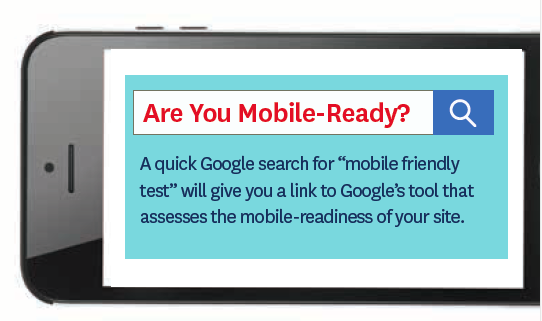 The idea makes so much sense. Why maintain multiple websites when I can maintain one? Responsive is also attractive in that an existing site can be retrofitted to be mobile-optimized without needing to redo the backend (and all the headache that can come with it).
The idea makes so much sense. Why maintain multiple websites when I can maintain one? Responsive is also attractive in that an existing site can be retrofitted to be mobile-optimized without needing to redo the backend (and all the headache that can come with it).
For the last few years, mobile optimization has been encouraged, but it was often hard to justify as a requirement. After all, people could find you in their searches just fine. Worst case was they may have to pinch and zoom around your site. As of April 2015, however, the worst case for not being mobile-optimized is your potential audience won’t even get a chance to see your website – because you will no longer appear (as prominently) in organic search results. Google made the decision to give mobile-optimized sites preferred ranking over non-mobile peers. … If you’re sweating about your site right now, don’t worry; you aren’t alone. This “mobile preference” is projected to affect the rankings of approximately 40 percent of the websites Google has indexed.
In this one outwardly simple change to how Google ranks websites, they have sounded a very clear decree. The mobile Web isn’t a trend or fad; its here to stay. To be digitally competitive, you have to be mobile-optimized, and responsive design is a great means to this end – but not the only one. Dedicated mobile websites are by no means dead and are in use on prominent Web presences. Neither is right or wrong, just a different tool, depending on the job. This being said, using responsive design for mobile optimization has become the defacto standard. A dedicated mobile site should only be considered if there are significant technical reasons why responsive would be neither possible nor practical.
Fifteen years ago, after we collectively got over worrying about Y2K, people actually debated whether the Internet was a fad or not. Today, nearly half the world’s population has access to the Internet – that’s a 741.0 percent increase over the same time. In the U.S. in particular, nearly everyone has access to the Internet (9 out of 10) – and 60 percent of the time they are accessing it through their phones. The desktop experience, of course, remains relevant, but mobile usage has reached a threshold that is too great to ignore.
If your business isn’t currently offering your mobile users an optimized browsing experience, it is time to start planning to offer them one. If you don’t, by this time next year, you might not have a mobile audience to be worrying about.
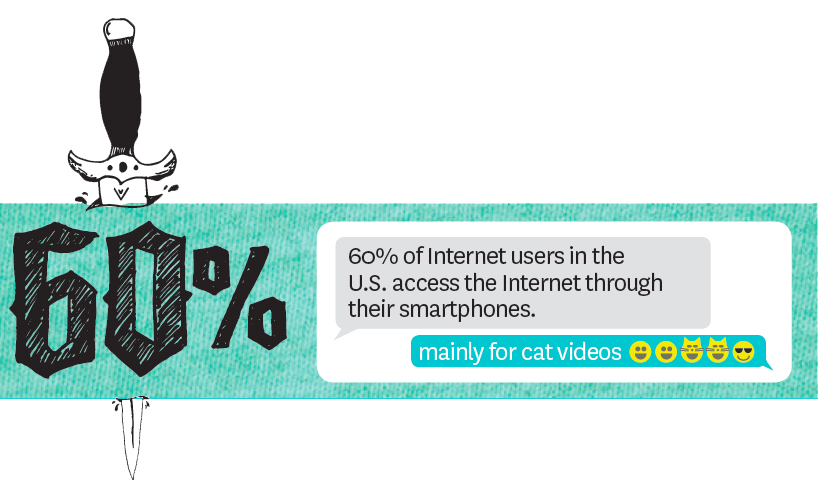
June 18th, 2015
Thinking: Great Expectations
Understanding the consumer’s mindset in order to generate brand loyalty.
Consumers have evolved, and will continue to evolve. Target audiences are ever-changing, with relevance playing an increasingly more important role in communication. The Internet and mobile technology have become the norm and an extension of our lives; behaviors and expectations have shifted to not just what, but when and where. We have gone from fax, phone and email to likes, comments and texts. Where marketing was previously about mass media channels, we must now think of everything as a channel.
Technology, social structures, brands, products and communication have all shifted significantly over the last 20 years, and so have consumers’ mindsets and expectations. The advertising industry has been focused on “integrated campaigns” – integrating different channels, such as social, digital and mobile with traditional and guerilla mediums. More important than the ever-changing channels and mediums is the mindset of the consumer. As millennials increase in their purchase power, as marketers we must understand their expectations and not only meet but exceed.
In order to fully understand which channels and messages should be crafted, we must first understand the new consumer mindset.
Six Integrated Mindsets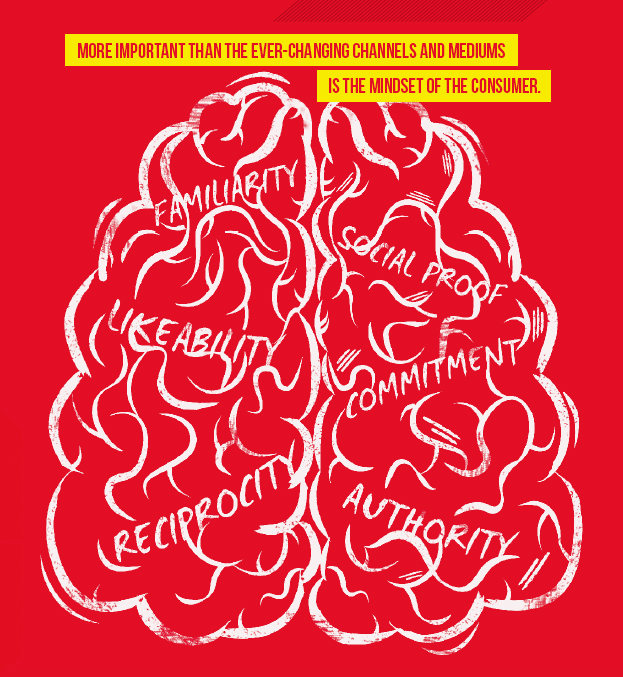
Familiarity
Building from the old-school goal of “awareness”, the expectation has shifted from just recall to a more personal connection: familiarity. The more times a consumer sees your message, the better. But the more they connect with the message, the more recall turns into caring for the product or brand.
Reciprocity
Beyond just telling consumers what they should feel or want, we should show them why they should purchase and interact with our brand. Brands, such as Toms, have capitalized on this mindset in an honest and authentic way – the philosophy of give, give, get. This doesn’t have to mean giving them discounts or coupons; it could be educational content like recipes or savings tips. The more you give utility and value, the more you will get from consumers.
Commitment
In the past, it was all about the “sale” and that first moment of truth – where a consumer is standing in the store aisle selecting which product or brand to purchase. Now there are many levels of commitment, from small pledges and comments to large commitments like an actual purchase. Each combination of these commitments builds that trust and fosters the relationship. The more people feel they have made a commitment to a brand, the more they feel obligated to fulfill their end of the agreement.
Social Proof
People trust people, not brands. Previously, it was all about expert reviews. Now, we as consumers look to other consumers for honest comments and reviews of the products and services we consume. Amazon has exploded with reviews and referrals based on this very mindset. We trust our friends, family and other consumers. Social proof is an endorsement. Activating advocates is imperative to solidify our credibility.
Likability
Fear tactics have been used successfully, but consumers want to like brands. They want you to be engaging, positive and helpful. For example, Dove focusing on self-esteem creates intense connection with the brand in a positive and engaging way. Consumers like the brand for the approach, and they not only recall messages and advertisements, they engage and share.
Authority
As the Internet has opened our world to real-time reports of anything and everything, building trust and credibility has become difficult for some brands. Creating authority in your industry requires transparency and education. Explaining what is important, why it is important and allowing consumers to see it unfold will build your brand’s authority, but, more importantly, it will build trust with your loyal consumers.
We must take from our past of reach, frequency and controlled messages and evolve. We must build relationships with our consumers – relationships based on generating interest, discovery and engagement. As we set up integrated campaigns, we must exceed these new expectations. If we keep these mindsets as objectives, we can truly connect with our consumers and convert them to brand advocates. Activate and facilitate conversations, slowly building lasting relationships that are independent of channels, campaigns and messages.
The 6 Integrated Mindsets are referenced in Dr. Robert Cialdini’s book “Influence: The Psychology of Persuasion”.
June 14th, 2015
Your People – Your Brand
Recent skirmishes with the Customer Service departments of two different companies left me with these questions:
- Why do I buy their products?
- Don’t these companies know what such horrible customer service does to their brand image?
So much is written about “brand ambassadors”. It’s not a new concept, of course…
Several years ago, I was a Regional Sales Director for a small company that grew and packaged specialty lettuces and greens. At the core of the product line was a beautiful green known as “mâche” or lamb’s lettuce. It’s very much a niche item, and the company’s marketing budget was tiny. The Marketing Director asked us to extend the reach of her limited resources by supporting her efforts as “Brand Ambassadors” in our Regions.
There we were, an army of three Regional Directors, dispersed across the Lower 48, equipped with emerald green attire, a megaphone, pom-poms, batons and a one-man-marching-band assortment of instruments. Well, I exaggerate a bit, but as Brand Ambassadors, we were INFORMED, and we carried THE BRAND MESSAGE fully in sync with positioning and strategy.
In contrast, the horrible customer service I experienced recently was (mis)served by two large, deeply resourced companies, one a medical device firm and the other a telecommunications/cable company.
The medical device firm boasts, “Our mission is to provide you with World Class Customer Service”.
The first customer service representative I spoke with told me she was having replacement parts for our machine shipped “Now”, and we would see them 24 -28 hours later by UPS. Nine days and at least a dozen customer service reps later, still no parts, but an email saying “… your job ticket is complete and therefore, closed”. And further follow-up calls, where customer service representatives see no record of earlier calls, emails or job tickets.
Please help us if this is what “World Class Customer Service” has come to mean!!
The telecommunications/cable company sees itself as “a leading provider of integrated communications solutions, including local and long distance voice, data, high-speed Internet and entertainment services that keep (area) residential and business customers connected with each other and with the world.
Service has been intermittent for 7 days. One day on the phone with customer service, I was rocketed around the world three times as various off-shore customer service representatives repeatedly transferred me to “someone who can help”.
Yes, I do feel connected with the world I guess. So…mission accomplished?
Brand strategy HAS to integrate ALL customer engagement points successfully. Does your Customer Service team put out a message – in words as well as in their service – that supports your brand’s position?
If there is a place for Brand Ambassadors, Customer Service is certainly it. Insist that the right people are on staff and expertly trained to support your brand’s strategy, position and messaging.
Your brand’s future may depend on it.
June 4th, 2015
Epic Facebook Fail
Facebook is a venue for networking, for keeping up with friends and family, for reaching out and expanding your horizons, and therein lies the danger.
Since my book was released in late 2011, I have had the opportunity and privilege to connect with authors from all over. These folks have expanded my horizons in so many more ways than I could ever have imagined. On a daily basis they teach me, make me laugh and make me think. I don’t even mind if they try to sell me one of their books – though I’d prefer a soft sell to some of the more in-your-face promotions. Having said all of this, I do have one major complaint.
When I receive an invitation to connect with someone I don’t know – I just naturally assume they’re an author. On several occasions I have been sadly mistaken and have been subjected to the stalky advances of some sniveling creep. Here’s the one I received this morning:
Hello,I am Kenneth, i love your good looking,How I wish words could express the thoughts that I have towards you. If I should say I love you then the greater percent of my words are still unexpressed.But of course, I must say something. my heart beats for you, and my heart longs for you.Can we have a conversation on. Thanks
Chat Conversation End
A number of my other Facebook “friends” have experienced a similar kind of stalky message, and we all find it unnerving. Perhaps this is why they do it – to make us feel unsettled.
I have a message for all of you Kenneths. Crawl back into your hidey-hole. You do not intimidate us – you sadden us. And to paraphrase a line from The Big Bang Theory, “you will never get a woman, that’s right, we all got together and took a vote!”
And as for everyone else – hell yes, I am going to de-friend him ASAP!
May 18th, 2015
B2B Companies: Did you Overlook a Lead Today?
Just a few months ago, we posed this question in our blog: “Should Business-to-Business Marketers Use Social Media?”.
Just as it was then, the answer now is “yes”, and a newly published B2B Social Media Report, adds further depth to the affirmative. Brandwatch, a social media monitoring and analytics firm, just released a study exhibiting that B2B companies miss more than 70,000 sales opportunities every year.
70,000.
This is from a survey of 200 of the top B2B companies in the US and the UK that also determined that nearly 25% of leading B2B brands do not have a social media account of any type.
So, 70,000 is an understatement. The Brandwatch study points to 72,756 “mentions” in social media that reflected an “intent to purchase” with language such as:
- “I’m thinking of buying…”
- “I’m looking to buy….”
- “I want to get…”
Through extensive research , Brandwatch learned that less than 1% of such mentions were engaged by companies that could fulfill the order.
The primary reason is that generally, B2B marketers have not been tuning in to conversations taking place through social channels. The solution, however, is not solely in “being” in social media.
As our earlier post counseled, social media communications need to follow a disciplined strategic plan that integrates with and supports the overall marketing strategy.
The Brandwatch study reinforces this, cautioning that many B2B brands rely almost exclusively on Twitter and Facebook, when their customers are active on news sites, forums, blogs and even video and image sites.
Extraordinary opportunity is out there. Has your organization given deep consideration to a strategic plan to capture it?
April 21st, 2015
It’s all about the widening mobile gap
The term “Mobilegeddon” has being bandied around the last few days by the media to characterize the change Google is implementing today relative to mobile search results.
While Google’s algorithm change will certainly impact many companies that don’t have mobile-ready sites, it’s a logical move. And one Google has been pushing for the last two years. In reality, we’ve ALL been talking about the impact of mobile and this change may be the push needed to make sites more usable for consumers.
Last year was a tipping point — the first time that adults in the US spent more time on mobile devices than they did on PCs. And given our mobile world, that gap will widen this year and continue to grow.
The fact is, the majority of US consumers now regularly use a smartphone and nearly half of the population now uses a tablet. More than a third of consumers are using both smartphones and tablets. A full 7 percent of US adults are completely dependent on their smartphones for Internet access.
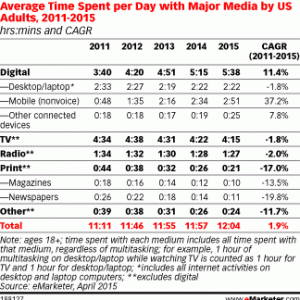 When you look at total daily media time per US consumer, it’s now at 12 hours and four minutes a day, up seven minutes from last year. With almost half of that spent on digital.
When you look at total daily media time per US consumer, it’s now at 12 hours and four minutes a day, up seven minutes from last year. With almost half of that spent on digital.
When you drill down by media, the growth rate of mobile is at 37% (CAGR). And that’s just the tip of the iceberg of what’s to come.
The fastest growing area on mobile is video consumption, with a staggering 91% CAGR. eMarketer’s data shows consumers are watching less TV, but spending more time with video in other places, most notably on their mobile devices.
Display and video will be the fastest-growing mobile ad formats as digital ad dollars quickly shift from desktop to mobile, and ad products improve. US mobile display and mobile video ad revenues are projected to grow at an astonishing CAGR of 96% and 73%, respectively, between 2013 and 2018.
This change won’t be without pain. Recent reports estimate that 40% of the leading sites failed Google’s mobile-friendly test and may be down-ranked in search. But it is good news for consumers, because it will push organizations to improve their sites to make them more usable on mobile devices.
April 20th, 2015
Perception vs. Reality – Makes All The Difference
In the business of communicating, perception vs. reality is a daunting concept. Sometimes we strive to make perception and reality align, and sometimes that alignment is not optimal. Regardless of which works best, we are fully aware that our ability to control perception is a lot like catching the wind. At best we can influence in an impactful way.
We talk about perception vs. reality a lot. I’m sure there are folks that think: is it really that big of a deal? I’ll share a little story – see what you think.
Nearly a decade ago I was vacationing in Capri. Shopping in a little department store in Anacapri, I noticed two salesmen. One looked to be the quintessential mediterranean god. He was dark and incredibly handsome, and he dressed the part of a wealthy playboy – a real treat for the eyes. The other, was more of a scrawny, dorky, older, weasely guy, (am I painting enough of a picture here?) and his clothes were that of a 1960’s file clerk – in fact, from the looks of it he might have had them since the 60’s.
As I continued my shopping, I became engrossed in a hand carved wooden box on a lower shelf. Debating between the hand carved lion and the giraffe, I sensed a nearby presence. Then, suddenly, I felt a pinch on the bum!
I have to admit, I had a brief moment of elation and then my head snapped around to see the culprit.
Moving away from me with a rapid gait was the weasely file clerk.
I have always regretted that turn of my head.
March 23rd, 2015
Is your site mobile ready?
Mobile first has gone from popular buzzword to crucial business strategy as Google updates its algorithm to increase rankings for mobile-friendly sites.
Starting April 21, Google’s changes could have significant impact on your mobile search rankings. If your site is mobile-friendly, expect to see an improvement. Sites that aren’t mobile-friendly will see a drop.
Because Google knows that redesigning a site will take a larger budget than most companies have, they are willing to accept page-by-page fixes. So for now, Google is ranking pages on a page-by-page basis rather than site-wide, and it’s doing its part to improve the mobile experience by rewarding the best pages in search results.
So what does this change mean for you exactly? In short, if your website is not mobile-friendly, meaning your site is not responsive to different screen sizes, properly configured and able to be viewed on multiple device types, your site could be penalized in search rankings. All the valuable SEO your site has currently could be for naught if your site isn’t viewable on a mobile device.
Why is this happening now?
The reasoning for this update is simple. 2014 was a tipping point in that over half of web traffic in the US now occurs on mobile devices. As the world moves to mobile and more and more of our lives occur in a handheld device, it is critical that websites are able to keep up. By rewarding those sites which are mobile friendly, Google is continuing to shape the digital landscape.
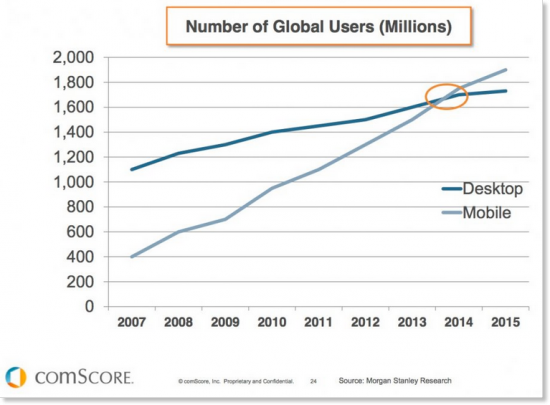
More people are consuming content through 4.5-inch screens rather than 15+ inch monitors, a major shift that will gain speed in coming years. As big as it is now, the mobile revolution is still ahead of us.
What Are We Doing on Mobile?
How do consumers use mobile devices to access the Web? According to Online Publishers Association/Frank N. Magid Associates:
- 99.5 percent access content/information
- 63.1 access the Internet
- 62.1 percent check email
- 49.2 percent listen to music
- 46 percent play games
- 41.7 percent download and use apps
- 15 percent make purchases
- 15 percent read a book
Shift to Mobile Impacts B2B Significantly
If you imagine that the mobile usage is merely a reflection of consumers logging onto social media, checking email or conducting search, or shopping, think again.
According to Seo toronto agency, executives lead the way in mobile adoption, validating the theory that digital assets for a business or brand must serve target audiences 24/7, and not just during business hours. Executives rely upon mobile devices (tablets and smartphones) to conduct business research more frequently in the evenings than any other time of day.
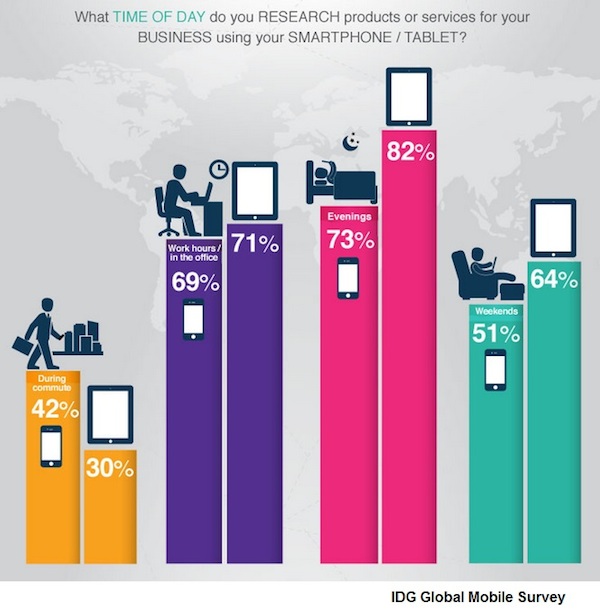
B2B Decision-Makers Rely on Mobile Devices
Mobile is preferred over the PC for executives conducting research during and after office hours, according to the IDG Global Mobile Survey 2014.
- 92 percent of executives own a smartphone used for business.
- 77 percent of executives use their smartphone to research a product or service for their business.
- 93 percent of executives will purchase that product via the Internet using a laptop or desktop.
- 86 percent use their tablet and 72 percent of executives use their smartphone to conduct research for products or services for their business.
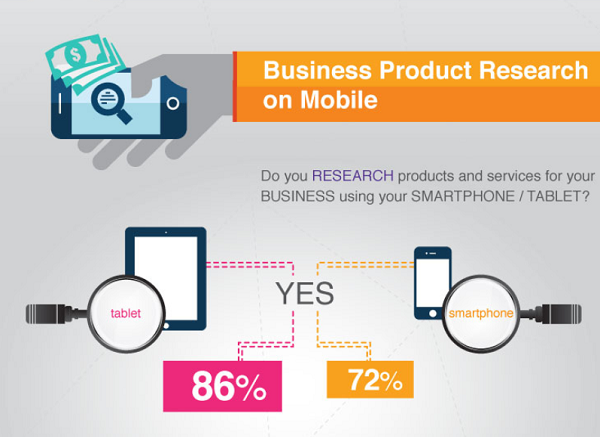
How Do You Know If Your Site Is Mobile Friendly?
Before you fret too much, you need to determine whether your site is at risk. To determine whether your website is currently being deemed “mobile friendly” by Google, there are two simple tests to run.
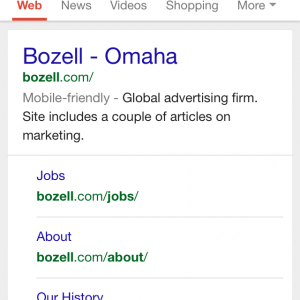 1. Check your site’s SERP appearances in a mobile browser. You may have already noticed that mobile-friendly tags are included in certain search results within Google searches on mobile devices. If your site shows up there, your site is already mobile friendly and you don’t have anything to worry about.
1. Check your site’s SERP appearances in a mobile browser. You may have already noticed that mobile-friendly tags are included in certain search results within Google searches on mobile devices. If your site shows up there, your site is already mobile friendly and you don’t have anything to worry about.
2. Run your site through Google’s Mobile-Friendly Test. Simply enter your URL into the grader. You can also check the Mobile Usability Report within your Google Webmaster Tools account for additional details on mobile compatibility issues across your site.
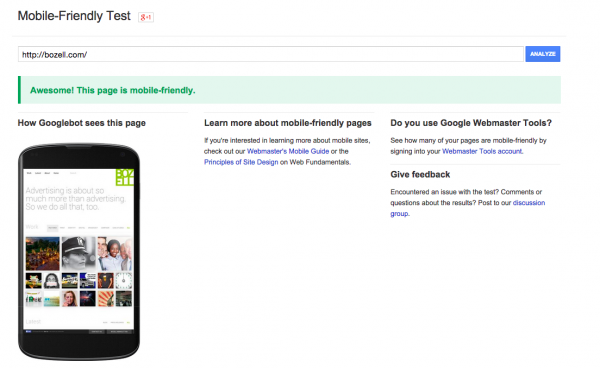 Google provides a 60+ page guide that discusses why and how to build a mobile-friendly website. There are dedicated guides for several open-source CMS platforms (WordPress, Drupal, Joomla, etc.), as well as a specific guide to mobile SEO, with special emphasis on avoiding common mistakes.
Google provides a 60+ page guide that discusses why and how to build a mobile-friendly website. There are dedicated guides for several open-source CMS platforms (WordPress, Drupal, Joomla, etc.), as well as a specific guide to mobile SEO, with special emphasis on avoiding common mistakes.
If you need help, give us a call.
March 13th, 2015
Robin Donovan Participating in a Panel of Business Entrepreneurs at the Creative Center
Bozell President Robin Donovan will be part of a panel of business entrepreneurs in a Campaign Management class in the BFA program at the Creative Center. The panel discussion will take place on Friday, April 24. Members of this panel will give a brief outline of how they started their business, and then answer questions from the class.
Robin is the president at Bozell. She began her career at Bozell more than 15 years ago, serving as vice president of media and then becoming partner in charge of media. In 2001, she was part of the four-person executive group that bought Bozell back from Interpublic. Prior to joining Bozell, Robin managed all media for the Connecticut, Chicago, San Francisco and Baltimore offices of BrannBlau. Robin brings vast knowledge and client management experience to the partnership. She has spent the past 25+ years helping clients to maximize value. As a graduate of the University of Connecticut, Robin served on the board of the Connecticut Ad Club and the Business Marketing Association. She is also a published author having written the murder mystery, Is It Still Murder Even If She Was a Bitch?


